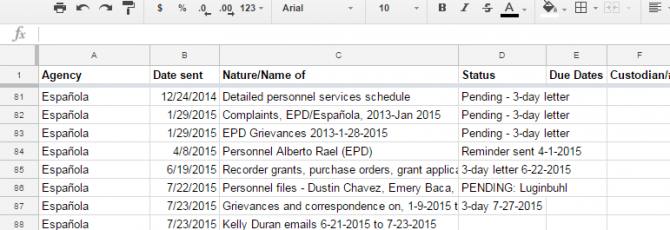If you’re a journalist like me, you have a lot of records requests pending at any one time.
If you’re not already keeping track of them in a spreadsheet or similar fashion, this article is to show you how it can be easily done, offer up a template, examples, and some organizational tips.
When I first started out, I didn’t know much about record requests.
That all changed when I started working at the Rio Grande SUN. Now, filing record requests is second nature.

A spreadsheet for open records requests makes it so much easier to keep track of everything.
Since I’m in New Mexico, it’s a lot easier than most states. New Mexico has a very requester-friendly open records law that allows for free inspections of records and offers few exemptions for public officials to withhold records.
That does not preclude me from filing FOIA, or Freedom of Information Act, requests with public agencies, although those requests compose just a fraction of my work. (My FOIA spreadsheet is just a copy of my IPRA spreadsheet that I modified.)
Keeping track of all of those requests, their statuses, when they were filed and all of the other important information can be somewhat easy, but it takes a little bit of organization, a spreadsheet and the determination to keep the spreadsheet updated.
As an example, I currently have 148 (as of June 4, 2017) open records requests. Keeping track of all of those demands some sort of organization.
I’ve only come to the helpfulness of spreadsheets in the past two or three years. Before, I always thought spreadsheets were for things that dealt with numbers. For everything else, I would use a normal text document.
For records requests, I used to just not do anything, other than a search through my email. Oh, how wrong I was!
So, let’s dive straight into the spreadsheet.
(Personally, I use Sheets in Google Docs, mostly because it is available wherever I log into my Google account. Attached at the end of this post is also an Excel version of my template as well as the example spreadsheet.)
Rows upon rows
Before I go any further, please remember, spreadsheets are a somewhat personal thing. I suggest you use a spreadsheet to keep track of your requests, but you should format the spreadsheet’s rows or columns to match what information you want to access.
The first row I use to sort requests is agency. This could be replaced with date, depending on your personal preferences.
Next is the date the request was sent. This is very important because it dictates deadlines and how late a request is in being fufilled. Plus, it’s a great row to sort by.
Everyone needs the first four rows (date, agency, documents requested and status) for a records request spreadsheet. Everything after that is what data you need to help keep track of your requests.
As an aside, when I send requests, I put the date I’m sending the request at the end of the email subject line. I use this as a sort of master reference point when trying to find the string of emails attached to the request.
I also make sure to put a very brief summary of the content of the request in my subject line. This, just like a date, adds another reference point.
An example of a subject line, which I condense for the spreadsheet:
IPRA – May 8 incident reports, supplemental reports, investigative reports, audio/video from incident & communications from — 5-28-2015
The next row is the request’s status, along with the last date of the last status, if it exists. If an agency sent the three-day letter (mandated in New Mexico law) on May 1, 2017, then I write: “3-day letter 5-1-2017.”
